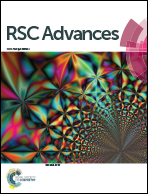Imidazole derivatives differentially destabilize the low pH conformation of lysozyme through weak electrostatic interactions†
Abstract
The structure–stability–function paradigm of proteins is highly governed by the pre-existence of repulsive and attractive non-covalent interactions. Electrostatic interactions with charged solvent molecules at the protein surface can contribute significantly to their stability. In order to unravel the electrostatic contributions of the positively charged species on a protein, we have studied the interactions of the imidazole derivatives (imidazole, histidine and histamine) with Hen Egg Lysozyme (HEL) in the pH range 4–2. At acidic pH, these compounds are reported to form charge transfer complexes (CTCs) with HEL through their protonated imidazole moiety with indole ring of protein's tryptophan. Although literature is available on the molecular geometry and functional roles of CTCs, no knowledge is available on the electrostatic interactions and stability attenuation features of these complexes. To unravel the stability aspects of HEL upon binding to imidazole derivatives, we have performed pH dependent stability and structural studies using various biophysical techniques. Our results evidenced a stability attenuation of HEL in the pH range 4–2, both in its apo conformations and also in complex with imidazole derivatives. Moreover, at pH values 4 and 3 all these positive charged compounds destabilized HEL by a Tm of 5–7 °C, leaving the pH 2 conformation untouched. Structural analysis suggested that interactive networks of negatively charged Glu/Asp residues of the protein with CTC forming compounds is responsible for such differential stability attenuation. We believe that our results are handy to the researchers in deciphering the contributions of weak non-covalent interactions in biomolecular recognition processes.


 Please wait while we load your content...
Please wait while we load your content...